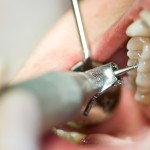
When restoring teeth establishing good contact points between adjacent teeth is important to minimise food packing. The aim of this study was to investigate the influence of cavity preparation (MO/DO/MOD) and type of matrix system on proximal contact tightness of direct posterior composite restorations.
85 patients requiring either a two- or three surface Class II direct composite restoration were randomly divided into two treatment groups. The first group was treated with a sectional matrix system combined with a separation ring (Palodent); the second group being treated using a circumferential matrix system in combination with a retainer (Tofflemire). Proximal contact tightness was recorded before treatment and directly after finishing the restoration.
They found that:-
- for the two-surface cavities There were statistically significantly tighter proximal contacts at both the mesial and distal sites when using a sectional matrix and separation ring compared with the circumferential matrix system.
- for three-surface (MOD) cavities no statistically significant differences were found between the sites, or the used matrix system.
- and no statistically significant influence of cavity design (mesially/distally) was recorded for all cavities (MO, DO and MOD).
The authors concluded
Use of the sectional matrix system in two-surface Class II cavities resulted in statistically significantly tighter proximal contacts than the use of the circumferential matrix system. For the three-surface no statistically significant differences in contact tightness were found between the different matrix systems. Location of the cavity (mesially or distally) did not show to have any statistically significant effect on the obtained proximal contact tightness.
Wirsching E, Loomans BA, Klaiber B, Dörfer CE. Influence of matrix systems on proximal contact tightness of 2- and 3-surface posterior composite restorations in vivo. J Dent. 2011 May;39(5):386-90. Epub 2011 Mar 21. PubMed PMID: 21414384.

aware the two studies are examining different methods but all techniques produced satisfactory contact areas in this paper
In vivo evaluation of different techniques for establishment of proximal contacts in posterior resin composite restorations
Cardoso P de C, Bastos de Oliveira AR et al. Brazilian Journal Oral Sciences 2011; 10: 12-16